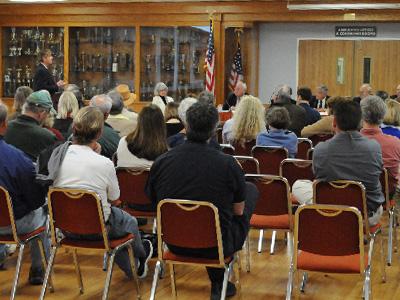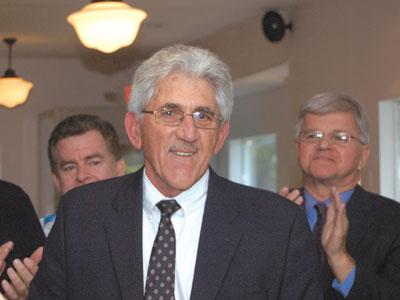Students as Chefs at Hayground
Students as Chefs at Hayground

“What should we have for lunch?” Arjun Achuthan asked the seven students seated around a wooden dining table on Monday at the Hayground School in Bridgehampton.
Clio Halweil, 5, voted for minestrone soup, Stella Hopson, 8, requested lasagna, and Colin Heilman, 6, made a plea for “garlic cheesy bread.”
After much back and forth, including a review of what they had just eaten, (pasta with lemon zest, roasted cauliflower, and a salad whose lettuces were grown in one of the school’s two greenhouses), students, who ranged in age from 5 to 11, discussed the elements of a balanced meal, the benefits of eating local foods, sustainably grown produce, and why deli meats, because of nitrates and high sodium, were to be avoided.
Lasagna, three-cheese garlic bread, and a green salad were ultimately chosen. Soon, students wriggled free of their seats and quickly dispersed, each with a job to do.
A handful of students paid a visit to the greenhouse to check on the kale and Swiss chard before stopping by the chicken coop, where they collected nearly three dozen eggs. Meanwhile, another group started chopping vegetables, setting the tables, and writing out the next day’s menu on a chalkboard. Scott O’Neil, who assists Mr. Achuthan in the kitchen, made a final dash to King Kullen for the remaining supplies.
The kitchen quickly filled with the aroma of basil and more than 50 cloves of garlic. Students, wearing hairnets, gloves, and aprons, stood on step stools to reach the counter tops. Each helped assemble the lasagna — repeating layers of sauce, pasta, and cheese.
“I just like to cook,” said Stella, who is in her first year at Hayground, having previously attended Southampton Elementary School. “It’s one of my favorite things.”
“I like that I get to find new recipes, and I just like making food,” said her classmate Noah Topliff, 8, who is in his fifth year at the school.
The culinary arts program, which was started in 2010, is an important part of the curriculum. While previously students brought brown-bag lunches, the 73 students now enrolled have a hot meal prepared by their classmates every day.
Jeff Salaway, the late owner of Nick and Toni’s restaurant in East Hampton, was one of Hayground’s co-founders. One of his dreams, according to Mr. Achuthan, was that students might grow, cook, and eat their own food. In 2005, the school broke ground on Jeff’s Kitchen, named in Mr. Salaway’s memory. But apart from a few batches of cookies, it sat unused for some time. Now, one side of the kitchen is undergoing construction — an expansion on the 13-acre campus to allow more classroom and dining space.
As a former classroom teacher, Mr. Achuthan, who runs the culinary program, appreciates being given two-hour blocks of time so that students can delve deeply into the tasks at hand. His own daughter, who is 5, attends the school, which he helped found.
In future years, Mr. Achuthan’s hope is for students to take increasing ownership of the planning and execution of the meals. He urges students to base menus around what the school has on hand rather than relying on trips to the supermarket.
When meal-planning for 80 (students and some staff), a consideration has to be the potential workload. A recent experiment in making homemade ravioli is unlikely to be repeated, he said. Following each meal, leftovers either go straight into the compost pile or into the chicken coop.
While in the kitchen, students are engaged in what Mr. Achuthan describes as an “authentic endeavor. The more real the job is, the more focused they are.”
On Tuesday afternoon, he finally sat down to enjoy a few bites of lasagna with venison sauce, made from a local deer that a parent had donated. The venison is the only meat that Hayground’s students have been served the entire school year.
Meanwhile, students waited in line for second helpings, passing around trays piled high with garlic bread.
Thirty minutes later, the next group of students raced into Jeff’s Kitchen to plan the next day’s lunch: quesadillas made with spinach and mushrooms.
“I’ve noticed that a lot of other schools have gardens and get momentum, and it often kind of fizzles,” said Mr. Achuthan, who emphasized the ongoing energy and commitment the daily program requires. “We don’t have that problem. The problem we have is if it ever stopped, we’d be hearing about it from the parents and the kids.”
The Hayground School is now 17 years old, having been founded in 1996 by several adults who had been associated with the Hampton Day School. A number of the founders remain active, each with an apparent sense of passion and purpose — dedicated to a school that teaches to life, not the test.
The school prides itself on its diversity. While annual tuition is $21,500, between 55 to 60 percent of students receive some financial aid, according to Jon Snow, a co-founder. The Hayground Camp, which offers programs each summer at a cost of $900 a week, helps offset as much as 60 percent of the school’s total costs.
“We wanted that full diversity, really a public school demographic,” said Mr. Snow. “It was really important to us not to be about privilege.” Of the continued involvement of many of the founders, he said the school was “a very compelling place for teachers to do what they got into teaching to do.”








